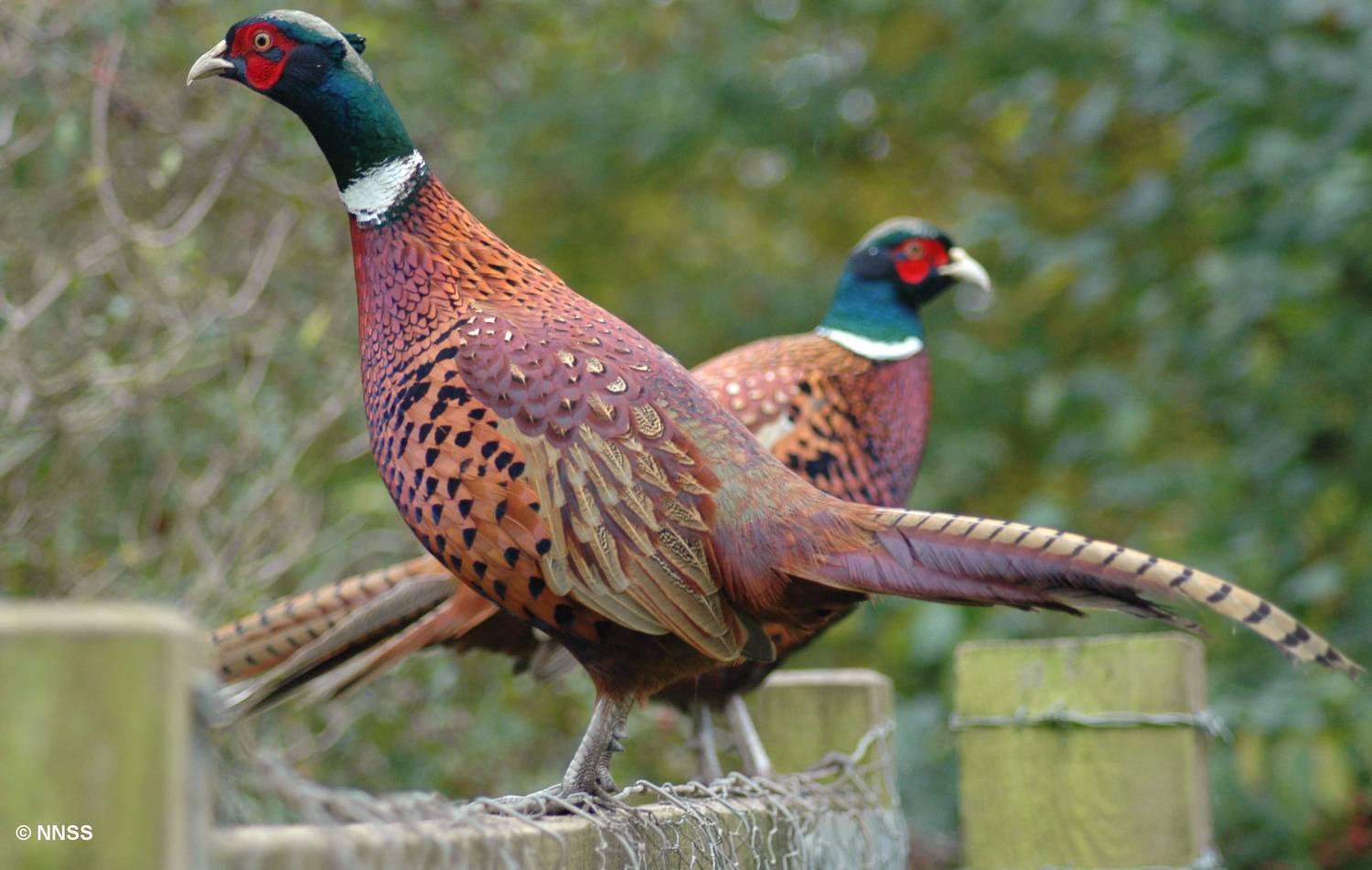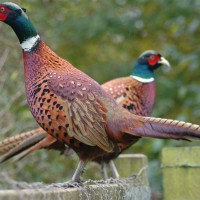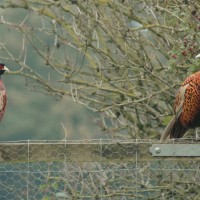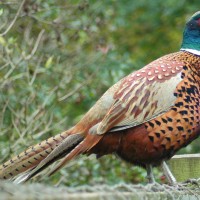
Common Pheasant - Phasianus colchicus
Expand and collapse the sections below by clicking on the title or + / - icons.
Short description of Phasianus colchicus, Common Pheasant
The common pheasant is a large, long-tailed bird with relatively short, strongly rounded wings. The typical male in GB has a coppery body, rump and wing-coverts, a dark greenish or bluish head, bare red face and usually a white neck ring. On shooting estates, released birds show a variety of plumage types created by selective breeding, including some with extensive pale blue rump and wing-coverts and dark variants ('tenebrosus'). The smaller females are buff-brown with darker patterning, especially on the upperparts.
Impact summary: Phasianus colchicus, Common Pheasant
Common pheasants have the potential for negative impacts on the native ecosystem as well as both positive and negative impacts on the human culture and economy of GB.
Claims that common pheasant have negative impacts on wildlife are numerous and subject to ongoing scientific evaluation but many remain anecdotal until the studies are complete. However following available best practice guidance can ameliorate the potential negative impacts and promote the positive impacts of gamebird releasing and management i.e. management of land for pheasant involves the retention, management and creation of habitat and the provision of food which have benefits to native species. Common pheasant also provide a cultural value to people and shooting activities in connection with common pheasant contribute to the economy.
Habitat summary: Phasianus colchicus, Common Pheasant
The common pheasant is mainly a bird of grassland, agriculture and woodland edge.
Overview table
| Environment | Terrestrial |
|---|---|
| Species status | Non-Native |
| Native range | Europe, Asia-Temperate, China, Mongolia, Afghanistan, Armenia, Azerbaijan, Bulgaria, Gruziya, Greece, Iran, Kirgizistan, North Korea, Kazakhstan, Laos, Myanmar, Russia Central, Russia East, Russia North, Russia Northwest, Russia South, Tadzhikistan, Turkmenistan, Turkey, Taiwan, Uzbekistan |
| Functional type | Omnivore |
| Status in England | Non-Native |
| Status in Scotland | Non-Native |
| Status in Wales | Non-Native |
| Location of first record | first record is unknown (ancient) |
| Date of first record | 1050 |
Origin
The native range of the common pheasant extends across temperate latitudes of the Palaearctic from the Caucasus and possibly Greece eastwards to China, extending on the Pacific coast from southern Russia to Hainan. The limits are hard to define exactly, owing to more than a thousand years of trade and introduction.
First Record
The common pheasant had been traded across Europe as far as GB by 1058 or earlier and was probably first introduced into the wild in GB during the 11th or 12th centuries.
Pathway and Method
Although historically kept in captivity and fattened for human consumption, the common pheasant soon became a bird established in the wild on private estates to be hunted for sport. Although up to two million females attempt to breed in the wild, a high proportion of common pheasants seen in GB during autumn have been reared in captivity and released, typically in July, before their shooting season opens on 1st October.
Species Status
This is one of the most widely introduced bird species in the world, with substantial non-native populations in many countries including almost every European country from Portugal and Ireland east to Finland and southern Russia, Morocco, the USA (including Hawaii), Canada and New Zealand.
Dispersal Mechanisms
Although common pheasants can run and fly strongly, their movements are rarely more than a few hundred metres. Birds generally remain within 5 km of where they were hatched or released.
Reproduction
In the spring territorial males establish exclusive territories to which they attempt to attract a group of females. Females lay a single clutch of eggs and raise their young independently of the males. Reproductive success can be significantly improved through targeted management both of habitats and predation control. This is practiced on many estates and farmland with an interest in wild game or the reproductive success of reared birds surviving the winter and shooting season into the following spring. Such management will also improve the breeding success of other birds, particularly ground nesting species and other species such as brown hares.
Known Predators/Herbivores
The main predators of adult pheasants, chicks and eggs include foxes, corvids, mustelids and, where locally abundant, raptors.
Resistant Stages
None known.
Habitat Occupied in GB
Common pheasants occupy most kinds of open country, reaching highest density where habitat including agricultural fields, small woodlands and game cover has been created or managed to suit them.
Common pheasants have been introduced or have spread to almost the whole of GB, including many small islands including Scilly, Lundy and many Scottish islands. There are records in recent decades on the Western Isles and Shetland, although it is not clear whether permanent breeding populations are established there.
Environmental Impact
Common pheasants are commonly released in GB and in specific cases there have been conflicts with native wildlife.
Health and Social Impact
An estimated 330,000 people shoot lowland game species (principally common pheasant) and enjoy the social and health benefits associated with this activity. Some people find the concept of releasing birds for sport shooting distasteful or strongly object to the practice but a proportion of those do recognise the benefits game management brings to the countryside. Pheasants can be a factor in road traffic accidents.
Economic Impact
Shooting sports are worth about £1.6 billion to the UK economy and large part of this value is linked with the common pheasant, be it money spent by participants directly on shooting or through the suppliers and supply chain. About £250 million is spent directly on practical conservation work by people who shoot, which includes habitat management and creation in addition to predator control activities. Economic damage by common pheasant is limited to compensation claims for damage to growing crops. The scale of the costs is not known but claims tend to be for highly localised areas (i.e. crops adjacent to a release site).
Pheasants can cause crop damage and may harbour Newcastle disease.
Identification
Svensson, L., Mullarney, K. & Zetterström, D. (2010) Collins Bird Guide. Second edition. HarperCollins, London.
Biology, ecology, spread, vectors
Hill, D.A. & Ridley, M.W. (1987) Sexual segregation in winter, spring dispersal and habitat use in the Pheasant (Phasianus colchicus). Journal of Zoology, London, 212, 657–668.
Management and impact
Aldous, E.W & Alexander, D.J. (2008) Newcastle disease in Pheasants Phasianus colchicus: a review. The Veterinary Journal 175, 181–185. doi: 10.1016j.bbr.2011.03.031
Hill, D.A. & Robertson, P. (1988) The Pheasant: ecology, management and conservation. BSP Professional Books, Oxford.
PACEC (2006) The Economic and Environmental Impact of Sporting Shooting. Public and Corporate Economic Consultants, Cambridge. full text
Reynolds, J.C., Stoate, C., Brockless, M.H., Aebischer, N.J. and Tapper, S.C. (2010) The consequences of predator control for brown hares (Lepus eruopaeus) on UK farmland. European Journal of Wildlife Research, 56, 541-549.
Tompkins, D.M., Draycott, R.A.H. & Hudson, P.J. (2002) Field evidence for apparent competition mediated via the shared parasites of two gamebird species. Ecology Letters, 3, 10–14.
Stoate, C., Szczur, J. & Aebischer, N.J. (2003) Winter use of wild bird cover crops by passerines on farmland in northeast England. Bird Study, 50, 15-21.
General
Code of Good Shooting Practice http:www.basc.org.ukencodes-of-practicecode-of-good-shooting-practice.cfm
BTO Bird Trends report page: www.bto.orgbirdtrendswcrpheas.shtml
Game & Wildlife Conservancy pages: www.gwct.org.ukresearch__surveysspecies_researchbirdspheasantdefault.asp
Johnsgard, P.A. (1999) The pheasants of the world. Smithsonian Institution Press, Washington, DC.
Madge, S. & McGowan, P. (2002) Pheasants, partridges and grouse. Christopher Helm, London.
Spotted this species?
Distribution map
View the Distribution map for Common Pheasant, Phasianus colchicus from NBN Atlas



